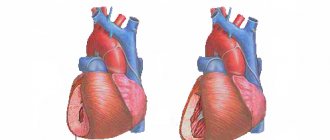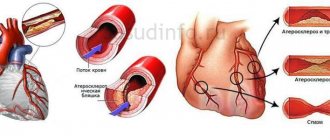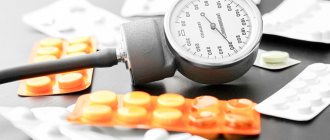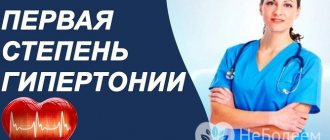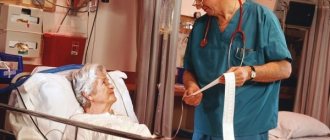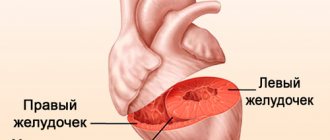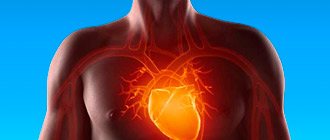Among all forms of high blood pressure, the most famous is essential hypertension, which can develop at any age. In complex cases, the disease leads to serious complications that significantly worsen the patient’s quality of life. As practice shows, it is most effective to treat essential hypertension in the early stages of its development.
Hypertension, which is chronically high blood pressure, is one of the most common health problems. Hypertension usually does not cause symptoms, so it is not always diagnosed in the early stages of development. It is a leading cause of heart attack, stroke, kidney disease and other serious medical problems.
The widespread prevalence and clinical significance of hypertension has meant that everyone should periodically check their blood pressure (BP). If you are diagnosed with hypertension, you should work closely with your healthcare provider to find effective treatment.
Essential hypertension (hypertension) requires rather difficult and lengthy treatment. The occurrence of pathology can occur for no apparent reason, and it is quite often detected in both adults and children.
Video: What is the essential form of hypertension?
What is essential hypertension and how does it differ from arterial hypertension?
Arterial hypertension is a general name for the process of increasing blood pressure. According to etiology (reason of origin) it is divided into two groups:
| Primary | Secondary |
| Essential. | Renoparenchymatous, renovascular, renal. |
The difference between essential (primary) arterial hypertension and its secondary (symptomatic) types is that the first is a pathological increase in pressure solely due to problems with the heart and regulation of vascular tone, and the second is a symptom of kidney disease and disorders in the excretory and endocrine spheres .
How high the blood pressure readings will be depends on the individual characteristics of the patient’s body and how long ago the pathology developed.
Accordingly, there are three degrees of severity of essential hypertension:
| Degree | Blood pressure indicators |
| First (1) | 140-160 by 90-100 |
| Second (2) | 160-180 by 100-110 |
| Third (3) | More than 180 to 100 |
Clinical signs
Symptoms of essential hypertension appear when the main internal organs are damaged - the heart, kidneys, blood vessels, and brain. For a long time, essential hypertension is asymptomatic, which complicates the work of doctors. The patient seeks help with an advanced form of essential arterial hypertension, when complex complex treatment is required to restore full functionality.
First (initial) stage
This is a mild stage of the disease, in which the disease manifests itself only in periodic increases in blood pressure. High blood pressure can be accompanied by migraines and severe weakness. Blood pressure increases due to excessive physical activity, stress, or excessive consumption of coffee or alcohol. Gradually, the load on the arteries increases, and the disease moves into the next stage.
Second (crisis) stage
At stage 2 of essential hypertension, the risk of developing a hypertensive crisis increases. It is necessary to monitor each new symptom that accompanies high blood pressure. The following signs indicate a hypertensive crisis:
- a sharp rise in pressure;
- soreness in the sternum;
- migraine;
- pre-fainting state.
If these symptoms appear, you cannot wait for the condition to normalize; you must call a doctor who will provide first aid, and then conduct an examination and prescribe comprehensive treatment for essential hypertension.
Third (severe) stage
At the third stage of essential hypertension, the pressure rises to critical levels and does not decrease even after the use of antihypertensive drugs. New signs are added to the main symptoms:
- organic brain damage;
- memory impairment;
- development of dementia;
- heart failure;
- renal dysfunction;
- metabolic failures;
- the appearance of protein in the urine;
- increase in creatinine level.
The changes that occur in the internal organs are irreversible. Regular monitoring by a specialist is required, the patient spends a lot of time in the hospital, treatment regimens are constantly changing and updated. The third stage of essential hypertension is often accompanied by heart attacks, strokes, and coma.
In the advanced stage of hypertension, heart failure develops
Particular attention should be paid to the appearance of the following symptoms:
- upper type of obesity (only the stomach increases in size);
- increased blood sugar concentration;
- increase in blood pressure over 130 to 80 mmHg;
- reduced levels of cholesterol and high-density lipoproteins;
- elevated triglyceride levels.
When three of the five symptomatic signs are combined, metabolic syndrome is diagnosed. This syndrome determines the degree of development of complications, as well as the risk of sudden death.
Classification
It is generally accepted to differentiate the pathological process by severity. Accordingly, they talk about essential benign and malignant hypertension.
The first proceeds relatively mildly, with low blood pressure readings, about 140 over 100, in isolated (when only one upper or lower reading is exceeded, for example 140 over 110) or typical hemodynamic form (when both systolic and diastolic levels are uniformly high). Manifestations are minimal, the patient may not even suspect that he is sick.
Likewise, the disease lasts for years, if not decades (20-30 years on average). At a certain point, the nature of the course can change dramatically towards a malignant transformation of the process. Then the pressure level will increase to 180-190 mmHg by 110-120, and this is not the limit.
Therefore, urgent treatment under the supervision of a specialist is necessary. It is advisable to bring down the pathological indicator as a matter of priority, only then you need to fight the main cause of the phenomenon.
Types, stages, consequences for organs
To simplify diagnosis, a classification of primary hypertension is used. It is carried out taking into account blood pressure parameters, characteristic signs, and health problems.
Doctors recommend
For effective treatment of hypertension at home, experts advise Phytolife
. This is a unique tool:
- Normalizes blood pressure
- Prevents the development of atherosclerosis
- Reduces sugar and cholesterol levels
- Eliminates the causes of hypertension and prolongs life
- Suitable for adults and children
- Has no contraindications
Manufacturers have received all the necessary licenses and quality certificates both in Russia and in neighboring countries.
We offer a discount to readers of our site!
There are several degrees and stages of pathology. The higher their score, the more serious the situation.
Degrees of primary hypertension:
- 1st degree of severity – set when the parameters on the tonometer are 140-159/90-99 mm Hg. Art.;
- 2nd degree – pressure within 160-179/100-109 mm Hg. Art.;
- Grade 3 – blood pressure more than 180/110 mm Hg. Art.
At the same time, the stage of the disease is determined taking into account the state of the body and existing problems in the functioning of internal organs.
Stage I of essential hypertension
At this stage, the disease differs in that blood pressure levels rise irregularly. This usually happens in cases of high physical activity or emotional shock.
There are no complications yet, the body’s organs are not affected. There are malfunctions in the functioning of the circulatory system, heart muscle, arteries, but they do not manifest themselves in any way.
This stage can go unnoticed for several years. The problem can only be detected by monitoring blood pressure.
Stage II of primary hypertension
If the disease is not diagnosed, the pressure rises constantly, but antihypertensive medications have a good effect on it.
Characteristic symptoms:
- hypertensive crises may develop;
- human organs are affected, especially sensitive to pressure drops in blood vessels (eyes, kidneys, as well as the heart, brain);
- atrophy of the muscular layer of the heart is possible, the first signs of the disease appear.
Causes of the disease
Factors in the development of the pathological process are diverse. Some are physiological, others are pathogenic. Sometimes it is impossible to distinguish one from the other, since they are closely intertwined and form a motley etiological picture.
Physical inactivity
Lack of physical activity. It is most common in elderly patients, bedridden patients and people who are characterized by a sedentary lifestyle due to professional activity.
As a result, there is a decrease in vascular tone, disruption of hemodynamics and brain nutrition. The result is the gradual formation of abnormalities in the heart and blood vessels.
However, it should be noted that pathological changes and the development of arterial hypertension do not occur in everyone. According to statistics, it suffers in approximately 70% of cases. But sooner or later, an essential type of pathology will form in the remaining 30% of people.
Older age
Hypertensive transformations in the body occur after 60. This is partly due to endocrine changes, on the other hand, the regulation of vascular tone is disrupted, and chronic stenosis occurs.
Together, these two reasons cause a persistent increase in blood pressure. Sometimes to significant levels.
Menopausal changes are typical for both women and men, but in the stronger sex the process is corrected more easily through the use of androgen-based hormonal replacement drugs.
History of diabetes mellitus
A systemic endocrine disease, which is characterized by the development of complex changes in the body, including cardiovascular structures.
The most dangerous consequences: gangrene of the foot, blindness due to the formation of pathological blood vessels.
Smoking for a long period of time
The effect of resins and other harmful substances on the state of hemodynamics. There is a decrease in blood flow speed.
The fluid connective tissue thickens, requiring more force from the heart to pump it. The pressure is steadily increasing.
Patients who consume tobacco products for a long time are especially at risk. So, according to statistics, patients who smoke a pack a day risk getting essential hypertension with a probability of 60%, two - almost 100%.
Giving up a bad habit at once is not enough: dramatic changes in lifestyle are necessary.
Atherosclerosis due to disorders of lipid metabolism in the body
Chronic narrowing of the lumen of blood vessels occurs. The blood cannot overcome the resistance, the heart activity and the intensity of the beat have to be accelerated. Hence the increase in blood pressure to significant levels.
At the first stage, this may not be so visible, but over time, as the plaque grows and calcifies, the process becomes catastrophic.
Alcohol abuse
Especially vodka and beer, which contain estrogens and change the nature of lipid metabolism. In addition, all the myths about the benefits of alcohol are nothing more than lies from the manufacturers.
A complete abstinence from ethanol is necessary. But this may not be enough, since the body adapts to pathological mechanisms and requires a new portion.
Therefore, patients who abuse alcohol often experience cardiac arrest due to withdrawal symptoms.
Obesity
A huge problem for the muscular organ and blood vessels. It should be borne in mind that increased body weight is rarely associated with eating habits alone.
Hormonal imbalance affects. Therefore, help is required from both a nutritionist and an endocrinologist. In system.
Stressful situations, physical overload
The release of a large volume of catecholamines and corticosteroids affects. These substances affect organisms differently. Therefore, it is difficult to predict in advance how much your blood pressure will jump.
In the chronic course, there is a constant increase in blood pressure to significant levels.
Burdened heredity
If there is hypertension in the family, the scenario may be repeated in future generations. In this case, a more severe course is likely (many authors, both domestic and foreign, point to a similar correlation).
Long-term infectious pathologies with damage to cardiac structures
Endocarditis and myocarditis are complications, but even with a rapid development they can leave a mark on the body in the form of essential-type hypertension.
It is also possible that a problem may arise with prolonged and significant consumption of table salt. The optimal amount of sodium compounds is 10-11 grams.
Treatment
The main goal of treatment for essential hypertension is to reduce the risk of mortality and cardiovascular and renal morbidity. According to recommendations based on the eighth Joint National Committee (JNC 8) guidelines, blood pressure should be:
- less than 140/90 mm Hg. for adults aged 18-59 years, including patients with diabetes or chronic kidney disease;
- less than 150/90 mm Hg. in the population over 60 years of age.
The American College of Cardiology/American Heart Association (ACC/AHA) recommends a BP target of less than 130/80 mmHg. for adults, regardless of age, with documented hypertension and known cardiovascular disease, or a 10-year atherosclerotic risk of developing cardiovascular pathologies (using the ASCVD risk score) of 10% or more.
For adults with established hypertension without additional markers of increased cardiovascular risk, a BP target of less than 130/80 mmHg can be set.
For patients over 60 years of age, the JNC 8 guideline recommends pharmacological therapy to lower blood pressure when blood pressure is more than 150/90 mmHg. The joint guidelines of the American College of Physicians and the American Academy of Family Physicians recommend that treatment begin in adults ≥ 60 years of age and in the presence of persistent systolic blood pressure greater than 150 mmHg. to achieve a target systolic blood pressure of less than 150 mm Hg. This can reduce the risk of sudden death, stroke and heart attacks.
Lifestyle change
The initial approach to a newly diagnosed condition should include a detailed explanation of the risks associated with hypertension and the need for adequate monitoring and adherence to therapy. Typically, the first therapeutic measure recommended is lifelong lifestyle modification. This includes:
- Reduce sodium intake (no more than 1.5 g/day).
- Potassium supplementation (3.5-5.0 g/day): Preferably through use of a potassium-rich diet unless contraindicated by chronic kidney disease or use of a drug that reduces potassium excretion.
- A diet suitable for stopping the progression of hypertension (DASH diet). Most often it consists of 8-10 servings of fruits and vegetables per day, whole grains, low-calorie proteins and low fat.
- Maintaining physical fitness, in particular, the waist circumference should be no more than 102 cm for men and 88 cm for women, while weight loss according to BMI is determined within 25 kg / m².
- Increased physical activity: at least 30 minutes of moderate-intensity dynamic aerobic activity (walking, running, cycling or swimming) 5 days a week, if allowed or recommended by a doctor
- Limited alcohol consumption: no more than 20-30 g of alcohol per day for men with hypertension and no more than 10-20 g of alcohol per day for women with hypertension. Total weekly consumption of alcoholic beverages should not exceed 140 g for men and 80 g for women.
Recommendations for lifestyle changes should be made according to the diagnosis, while other therapeutic measures must also be implemented. Before starting an exercise program, patients should discuss their exercise plan with their doctor.
Most patients require drug therapy to achieve target blood pressure levels. Antihypertensive drugs are used for this. Examples of the major classes of antihypertensive agents that have been recommended by JNC 8 include:
- Diuretics: thiazide (or thiazide-like), hydrochlorothiazide, chlorthalidone.
- Indapamidase inhibitors: lisinopril, enalapril, captopril.
- Angiotensin II receptor antagonists: candesartan, irbesartan, losartan, valsartan.
- Calcium blockers: amlodipine, diltiazem.
- Beta blockers: metoprolol, atenolol.
Beta blockers are not recommended for the first-line treatment of hypertension except in cases of coronary artery disease, myocardial infarction, or atrial fibrillation.
The antihypertensive drugs listed are typical examples from each class. Some of these agents are offered in fixed dosage formulations. These single-dose tablets simplify the dosing regimen and improve the achievement of a therapeutic effect.
Treatment of the elderly
Treating hypertension in very elderly patients is challenging, especially according to conventional BP goals. These difficulties arise for a number of reasons, including concerns about the risk of severe blood pressure drops, interactions with other drugs, side effects and lack of benefit in reducing mortality.
Previous literature reviews and meta-analyses have demonstrated reductions in stroke, heart failure, and cardiovascular events in the very elderly without increased mortality. [1 - Charpentier MM, Bundeff A. Treating hypertension in the very elderly. Ann Pharmacother. 2011;45:1138-1143] However, the SPRINT study found that treating outpatient adults aged 75 years and older to a systolic blood pressure <120 mm Hg. Art. resulted in significantly lower rates of fatal and nonfatal major cardiovascular events and death from any cause compared with systolic blood pressure levels up to 140 mmHg. [2 - Williamson JD, Supiano MA, Applegate WB, et al; SPRINT Research Group. Intensive vs standard blood pressure control and cardiovascular disease outcomes in adults aged ≥75 years: a randomized clinical trial. JAMA. 2016;315:2673-2682]
The 2020 ACC/AHA guidelines recommend a target systolic pressure of less than 130 mmHg for outpatient older adults. Art. For older adults over 65 years of age with hypertension and a high comorbidity burden and limited life expectancy, clinical judgment, patient preference, and a team approach to risk/benefit assessment make decisions regarding the intensity of BP lowering and the choice of antihypertensive medications wisely.
According to European recommendations in elderly people with systolic blood pressure more than 160 mm Hg. you need to lower the indicator to the target blood pressure level from 150 to 140 mmHg. The indicator is less than 140 mm Hg. may be considered for elderly people under 80 years of age, while systolic blood pressure should be adapted to the individual tolerance of the elderly patient.
The JNC 8 guideline recommends starting pharmacological therapy in patients over 60 years of age with a systolic blood pressure greater than 150 mmHg. or diastolic blood pressure more than 90 mm Hg. Art.
Possible complications on internal organs
With a long course of the disease, damage to the following target organs is observed:
- Brain. The main pathologies are stroke, a transient circulatory disorder in cerebral structures. The most dangerous option, at the same time, the most common.
- Heart. Heart attacks, ischemic heart disease, congestive insufficiency and this is not the limit. Cardiogenic shock and sudden organ failure are possible.
- Eyes. Ruptures and detachments of the retina as a result of sudden surges in blood pressure and bleeding into the vitreous body. Urgent medical attention is required.
- Kidneys. Insufficiency, other pathological processes associated with impaired filtering function.
Often a complex of pathogenic changes in several systems and organs is noted at once. Essential primary hypertension is a source of destructive effects on the heart, blood vessels, and visual structures.
Target organs for essential hypertension
It must be said that systolic pressure increases with age, while diastolic pressure decreases slightly after 60 years of age in men and after 10 years in women. Various factors (environment, endogenous regulatory systems, etc.) are involved in the onset of the disease. But essential hypertension in adults can develop secondarily, representing a consequence or manifestation of endocrine diseases, diseases of the kidneys, blood vessels, heart and other organs.
Target organs are mainly the following organs:
- kidneys;
- vessels;
- heart.
Hypertension (high blood pressure) manifests itself depending on the degree of damage to these organs.
Characteristic symptoms
Manifestations of the pathological process are varied; there is a whole list of signs from organs and systems:
- Nausea. It is explained by dysfunction of the cerebellum, which does not receive enough nutrients and oxygen.
- Vomiting of an indomitable nature. Repeatedly, without signs of relief. It is of reflex origin.
- Cephalgia. The pain is localized in the back of the head, stabbing, shooting. There is no relief after the use of anti-inflammatory and analgesics.
- Dizziness. There is a lack of coordination, up to the inability to move normally and even stand. Normalization of the condition involves increasing blood flow and removing stenosis of the vessels supplying the vestibular apparatus. The activities take place in a hospital setting.
- Weakness in the legs, pins and needles sensation in the limbs (paresthesia).
- Paralysis of half the body, paresis (partial limitation of functional muscle activity).
- Speech problems. A dangerous sign that indicates the development of a stroke or transient cerebrovascular accident.
- Weakness of facial muscles. The patient cannot smile, the face may become distorted. Also a characteristic feature of problems with cerebral structures. Need urgent help.
- Shortness of breath at rest.
- Problems with vision. The patient cannot focus his gaze on an object, the image is double, photopsia and scotomas (loss of visual fields) are possible.
- Noise in the shah, transient deafness.
Pathogenesis
The specific mechanisms of the disease are not fully understood. It is impossible to say with certainty what malfunction in the body led to hypertension.
It is believed that the disease is based on various disturbances in the functioning of the system responsible for regulating blood pressure.
The following pathogenetic theories of the development of essential hypertension are distinguished.
Neurogenic
As a result of exposure to chronic stress, the activity of the sympathetic nervous system (responsible for the “fight or flight” response) increases excessively. There is a massive release of mediators. Through nerve fibers innervating the smooth muscles of blood vessels, mediators cause their spasm. Preganglionic fibers going to the adrenal glands stimulate the production of catecholamines (adrenaline) and cortical hormones (cortisol), which also has a pressor effect.
Humoral
Disturbances in the balance between biologically active substances that constrict and dilate blood vessels. Excessive release of hormones that constrict blood vessels - catecholamines, cortisol, aldosterone, renin, vasopressin, angiotensin 2 and insufficient secretion of vasodilators.
Membrane
Some people have a genetic defect in the functioning of membrane pumps that are built into smooth muscle cells. This causes them to stop removing excess sodium from the cell cytoplasm. Excess ions cause prolonged vascular contraction.
Dysregulation of blood pressure by the kidneys
Sodium accumulates in the body due to the fact that the kidneys stop removing it. As a result, the volume of circulating blood increases and the sensitivity of blood vessels to the action of pressor substances increases.
Changes in the functioning of baro- and chemoreceptors
Normally, the carotid sinus and aortic arch contain receptors that record pressure (baroreceptors) and the concentration of chemicals (chemoreceptors). When pressure decreases or carbon dioxide concentration increases, they send signals to the vasomotor center located in the medulla oblongata. This causes an increase in blood pressure.
An increase in pressure can be easily detected even before measurement by a number of signs. For convenience, they were divided into several groups depending on the mechanism of occurrence.
Symptoms of arterial hypertension
Neurological
The most well-known symptoms - tinnitus, a feeling of pulsation in the temples and headache - belong specifically to this group. They are caused by impaired blood flow in the brain, which is very sensitive to a decrease in oxygen concentration in the blood. This also includes “floaters” before the eyes, insomnia, irritability, increased fatigue, decreased attention and memory, and drowsiness.
Vegetative
Sweating, redness of the face, palpitations, irregular heart rhythm. They arise as a result of activation of the sympathetic system (the body views increased blood pressure as stress) and a sharp release of adrenaline.
Caused by the accumulation of excess fluid in the intercellular space
This group includes: swelling of the limbs, numbness and a feeling of heaviness. This occurs due to increased vascular permeability and too much salt consumption.
Symptoms that require calling an ambulance
- An increase in blood pressure to 180 mmHg, 110 or higher. Indicates the likelihood of developing a hypertensive crisis.
- Facial distortion.
- Paresis, paresthesia and paralysis.
- Acute headache, unbearable.
- Interruptions in the functioning of the heart such as arrhythmias.
- Fainting, syncope.
- Problems with speaking.
If at least one sign is detected, it is necessary to call an ambulance and transport the patient to a hospital. Arterial essential hypertension is the cause of emergency conditions: strokes, heart attacks, cardiogenic shock, arrhythmias.
Second stage: possible crisis
At stage 2, the symptoms of the disease become more pronounced and may be accompanied by hypertensive crises. A crisis is a sharp jump in blood pressure, which causes a change in blood flow in the internal organs, and a possible disturbance in the psycho-emotional background. A hypertensive crisis can be triggered by:
- poor nutrition, incl. a lot of salt in the patient’s diet;
- sudden change in weather conditions.
Symptoms of a hypertensive crisis in hypertension of the 2nd degree, 2nd risk level are as follows:
- pain in the sternum area, radiating to the shoulder blade;
- Strong headache;
- dizziness;
- possible loss of consciousness.
At this stage, of course, it is no longer possible not to notice the disease. Therefore, it is precisely when such symptoms appear that the patient often comes to the doctor and is diagnosed with “essential hypertension.” The patient will learn what it is from the attending physician, who will prescribe the necessary examination and recommend treatment. At the 2nd stage of the disease, taking medications that lower blood pressure alone will no longer have the desired effect. A comprehensive treatment is required that can guarantee constant control of blood pressure levels.
Necessary examinations
Patients with essential hypertension are diagnosed by cardiologists. Specialists of a different profile are required only if there are abnormalities in the kidneys, excretory, or endocrine systems.
Among the measures:
- Assessing patient complaints, examining symptoms and determining the clinical picture. Anamnesis collection. The subject to observation is lifestyle, family history of diseases, tendency to bad habits, dietary habits, as well as the presence of somatic pathologies of a non-cardiological nature.
- Measure blood pressure on both arms to get an accurate result.
- Heart rate study. Tachycardia, bradycardia, and other types of arrhythmias can tell a lot. Including the state of the vascular system.
- Electrocardiography. Methodology for studying cardiac activity. In the hands of a competent doctor, this is a powerful diagnostic tool. However, high qualifications are required.
- Echocardiography. An ultrasound method for assessing the physical characteristics of the heart.
- Encephalography. Necessary for studying brain rhythms.
- Daily monitoring. Allows you to identify the dynamics of changes in blood pressure throughout the day. An automatic programmable tonometer is used.
- Angiography of blood vessels.
- Study of blood flow in the neck and brain using Doppler ultrasound. A reliable and relatively accessible method for identifying problems with cerebral structures.
Comprehensive diagnostics allows you to accurately identify the cause of essential arterial hypertension and begin timely treatment. This is especially important in cases of malignancy with sudden, gross changes.
Diagnostics
For treatment of essential hypertension to be successful, you need to take care of your health in the early stages of the disease. Although stages 1 and 2 have practically no signs of the disease, except for increased blood pressure, you still need to listen to your body as much as possible and go to the doctor at the first suspicion.
How can a doctor identify this disease? First, he conducts a general examination of the patient - measures pressure, listens to the heart, checks it for murmurs. The doctor also evaluates the condition of the retina. To confirm the diagnosis and dispel doubts, the data obtained during the examination must be supported by the results of research and analysis.
First of all, you need to take a urine and blood test, and then be examined using special diagnostic equipment. For idiopathic hypertension, a mandatory examination method is a cardiac cardiogram. It helps to identify left ventricular hypertrophy in the early stages of the disease and prevent deterioration of the patient’s condition. Using echocardiography, you can determine the pathophysiology, size and function of the heart, and evaluate the functioning of the valves. In order to establish such a diagnosis, a one-time pressure measurement is not enough; it is necessary to monitor these indicators for a long time. Using a special device that is placed on the patient’s belt, it is possible to carry out daily monitoring of blood pressure.
By taking an X-ray of the chest organs, it is possible to identify atherosclerotic changes in the vessels and disorders of the lung tissue.
Only after receiving all the results of the study can we talk about the disease and its treatment. This diagnosis can only be made by a specialist, and only with him it is necessary to develop an action plan aimed at improving the patient’s condition.
Therapy
The methods of influence are varied. The following groups of drugs are prescribed:
- Alpha and beta blockers.
- Calcium channel blockers.
- ACE inhibitors.
- Diuretics to accelerate the removal of fluid from the body and prevent edema, including edema of the lungs and brain in severe cases.
- Analgesics for severe chest pain or cephalgia. Often used as a first aid measure.
Specific names, combinations and dosages are selected only by a doctor. It is not possible to do this on your own.
Conditions such as cardiogenic shock are treated with dopamine and adrenaline. But the mortality rate in this case still remains high: about 80-100%.
An important measure is to stop smoking. Also, you should not drink alcohol, even in minimal quantities. Apart from vascular stenosis, there will be no further effect. Drinking regime, diet, and the nature of physical activity are also adjusted by the doctor.
Medication methods
Essential arterial hypertension is treated only with medications prescribed by a doctor. Modern methods provide complex treatment using several groups of drugs simultaneously:
- Diuretics are indicated for long-term use and are used to relieve a hypertensive crisis.
- ACE inhibitors (Capropril, Lisinopril) help reduce the risk of complications, are taken for a long time, and are necessarily prescribed for pathologies of the heart or kidneys.
- Calcium antagonists help relax the walls of blood vessels, reduce spasms; they are most often prescribed to patients with coronary heart disease, myocardial hypertrophy and cardiac dysfunction (Verapamil).
- Beta-blockers reduce the load on the heart, lower blood pressure, and provide an analgesic effect for angina (Atenolol, Metoprolol).
- Imidazoline receptor agonists are used in the treatment of patients with diabetes mellitus and obesity who have been diagnosed with essential hypertension. What it is can be explained as follows: these are drugs for weakening the links in the control of the cardiovascular system and improving metabolic processes in the body, with minimal side effects (“Moxonidine”).
- Angiotensin II receptor antagonists are a modern group of selective medications (Losartan, Valsartan), their only drawback is their high cost.


